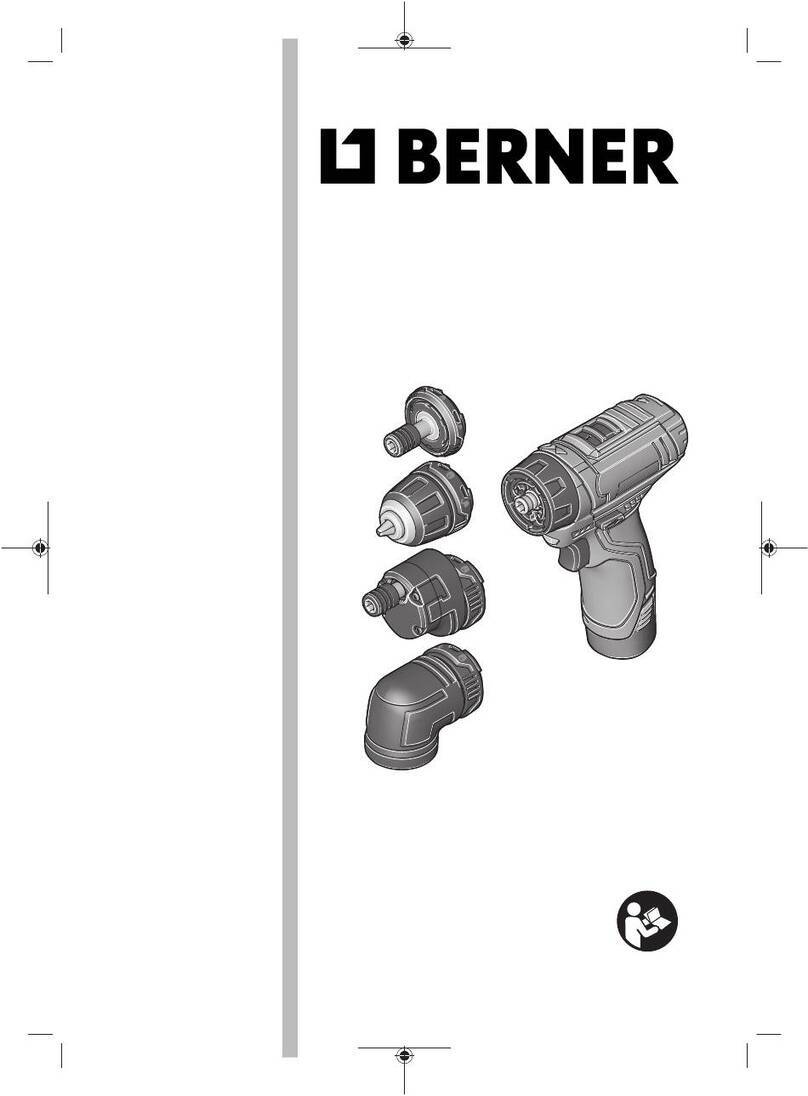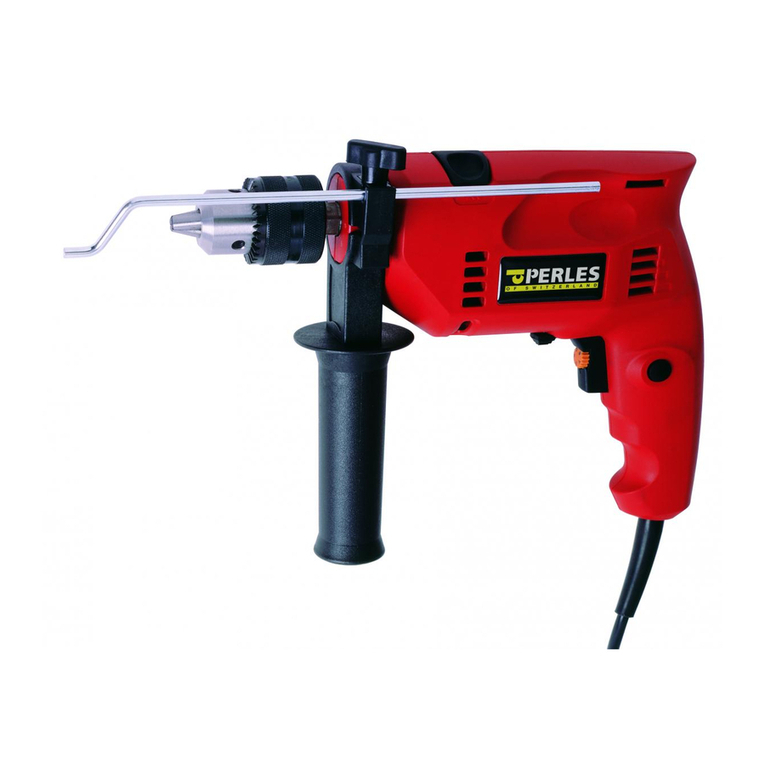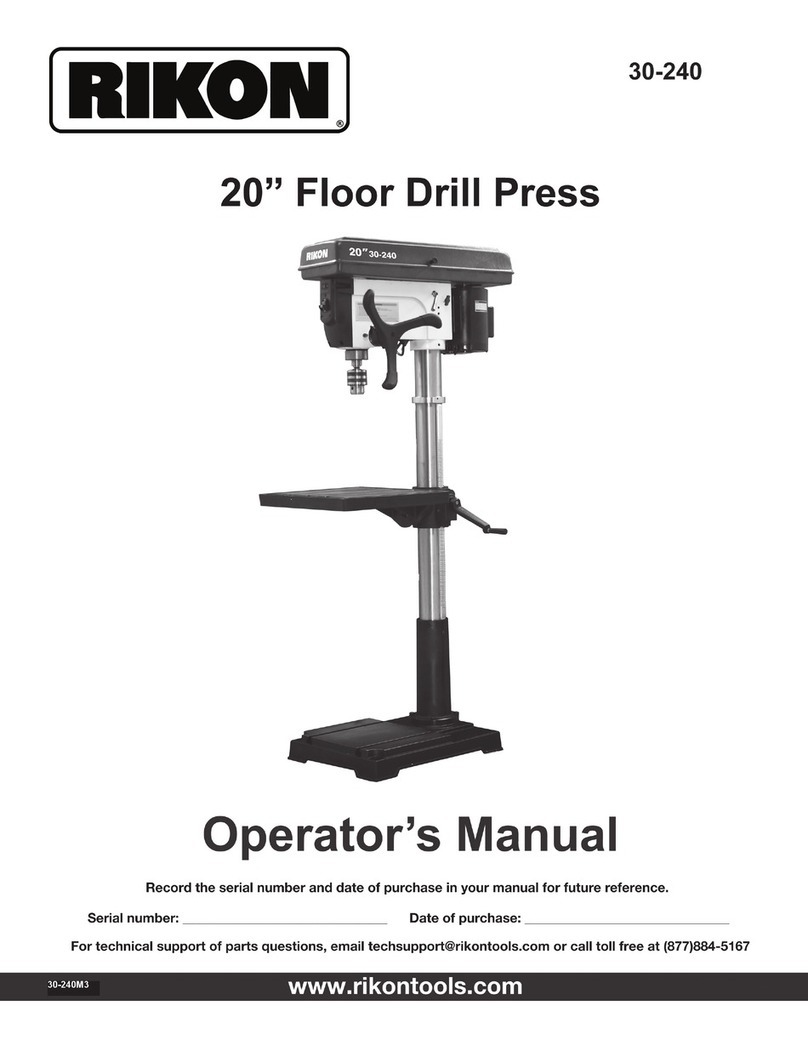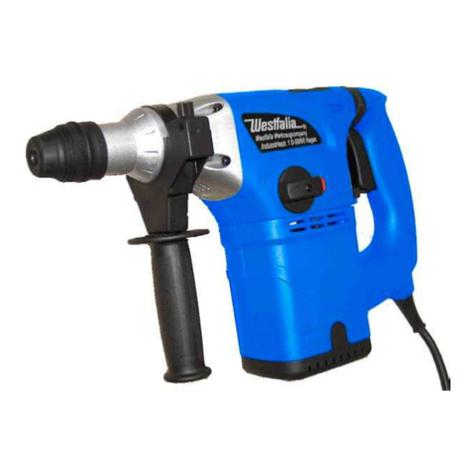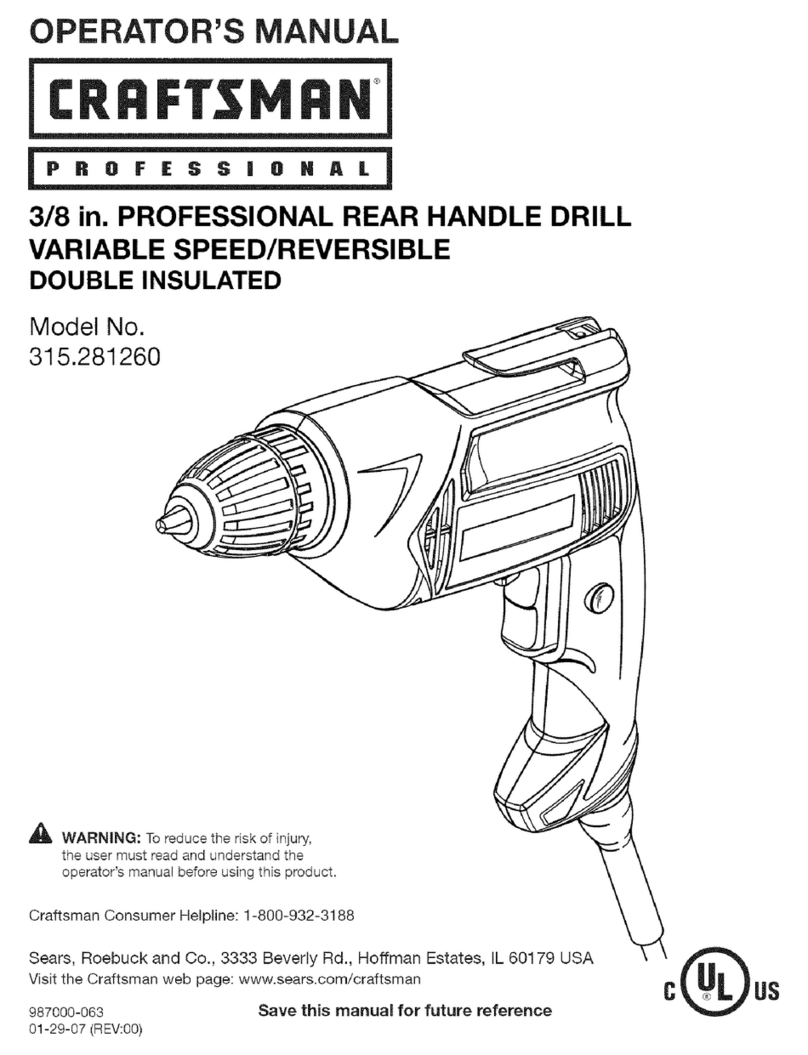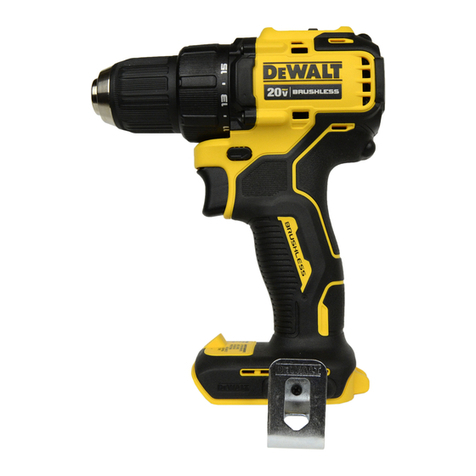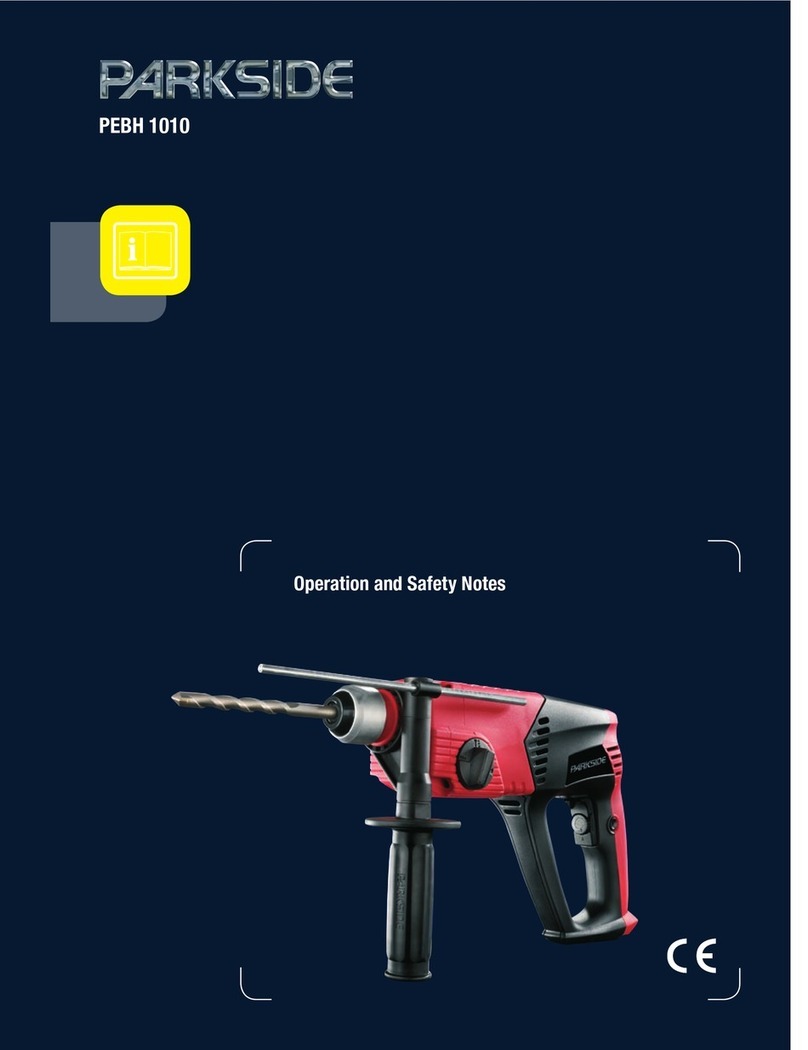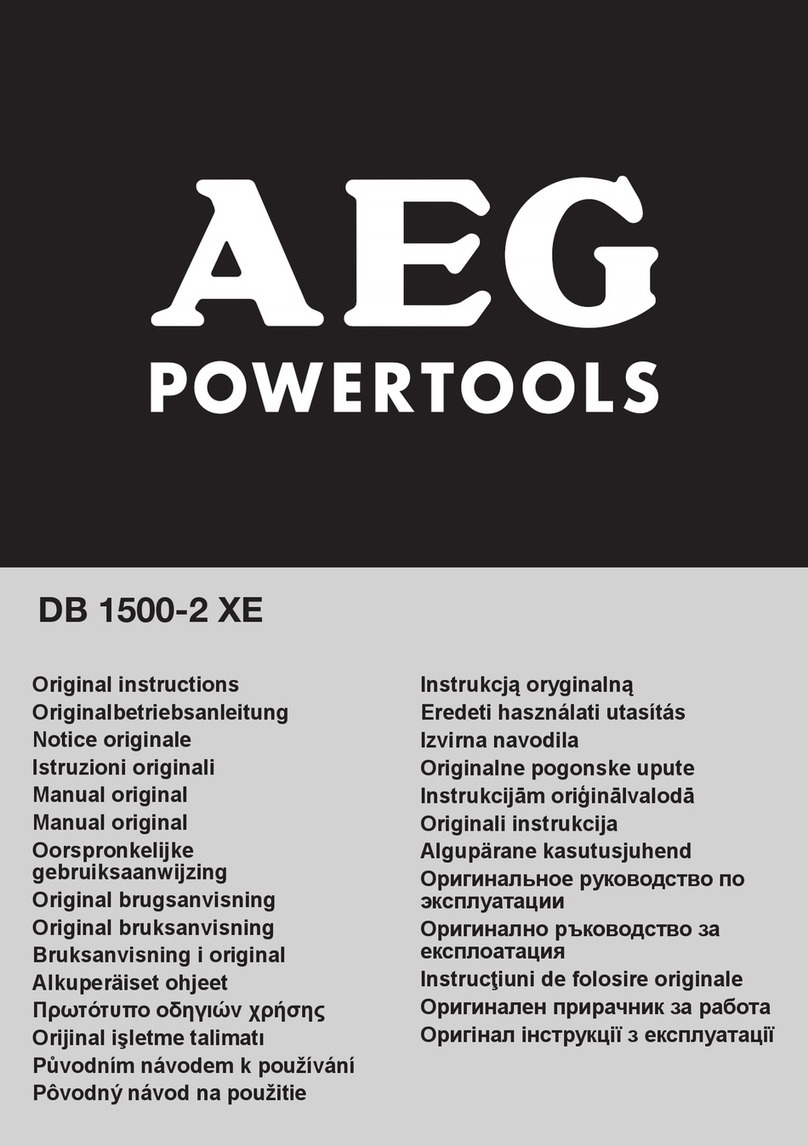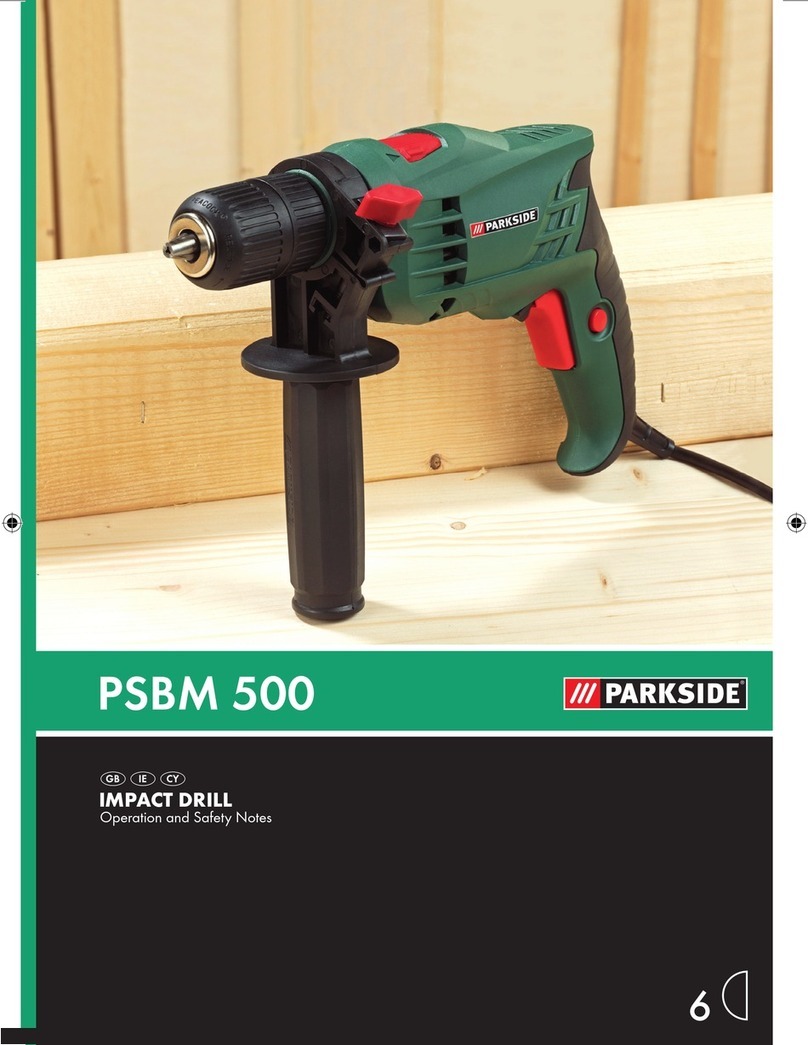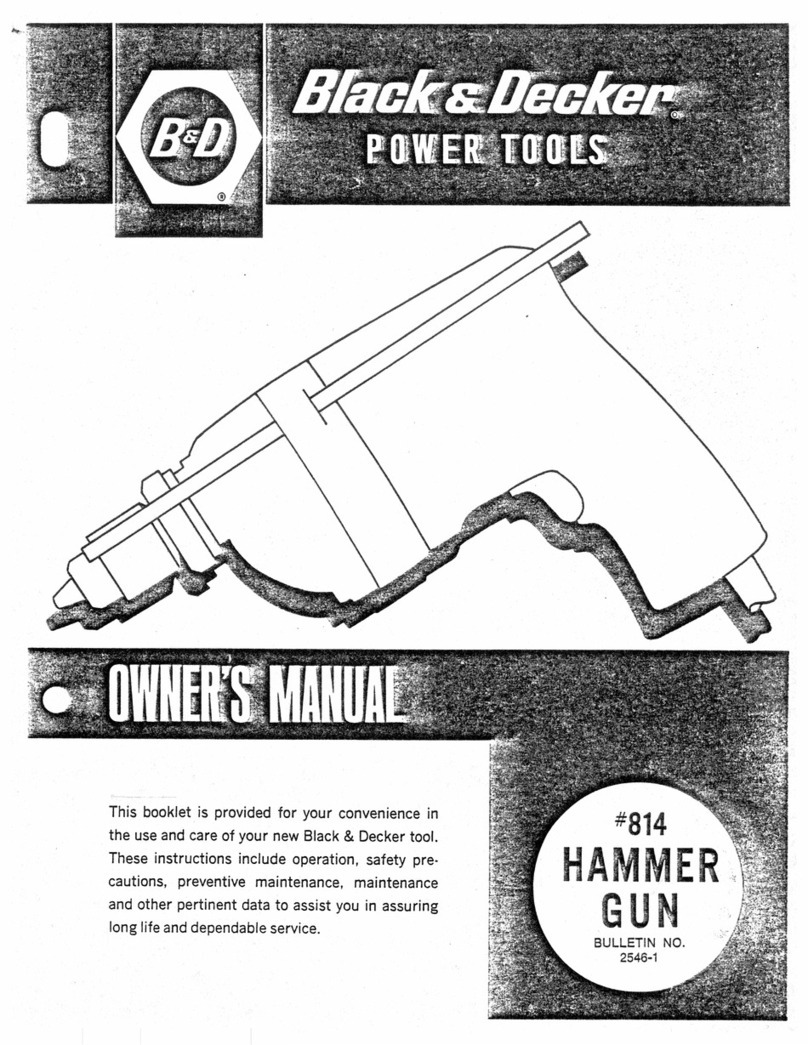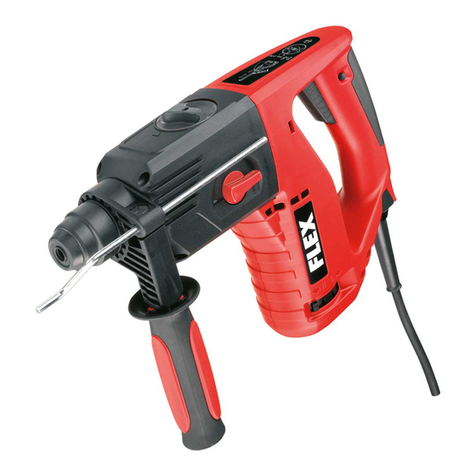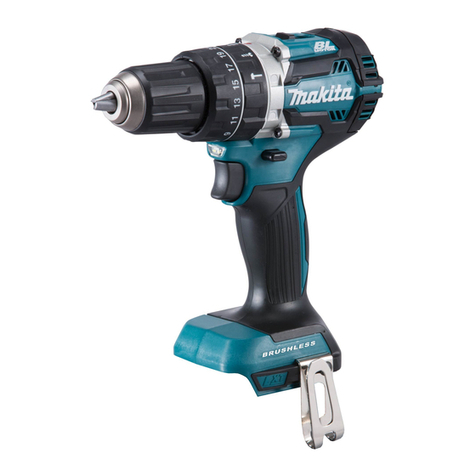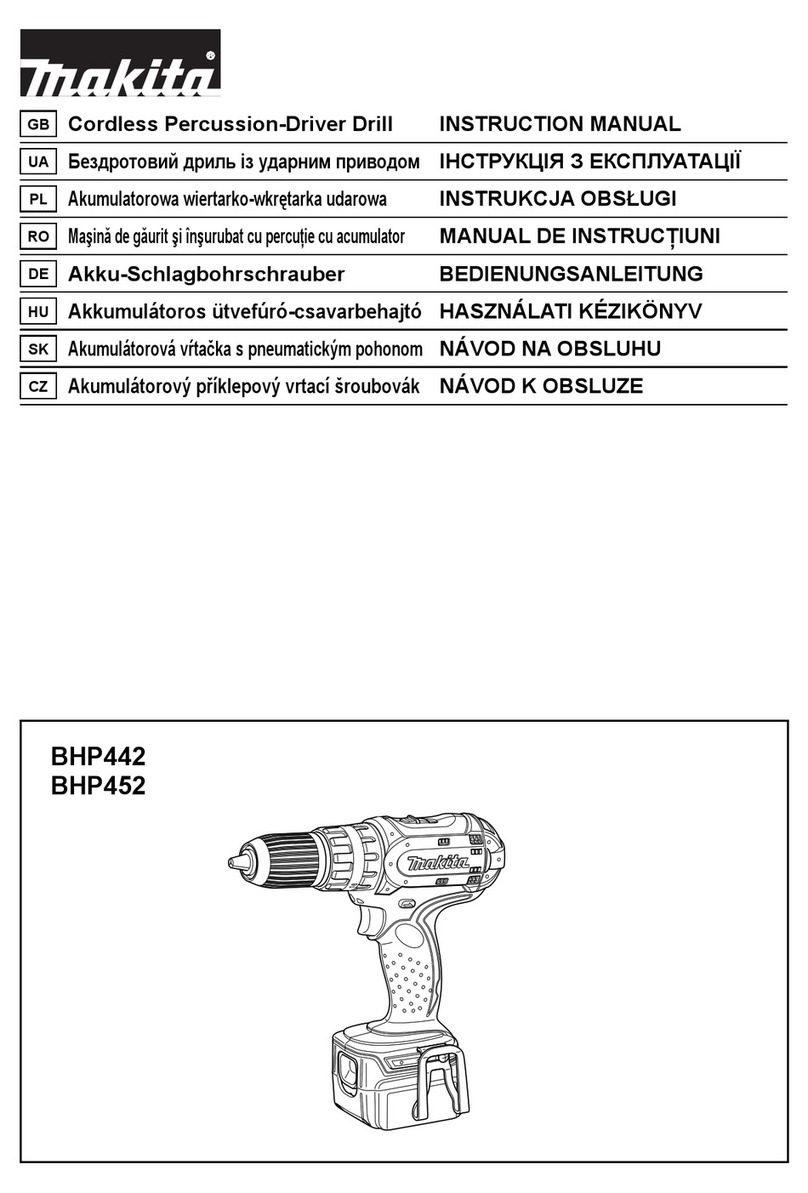Tork Craft TC20001 User manual

DRILL DRIVER
CONDUTOR DE PERFURADORA
TC20001
Instruction Manual
Manual for the Tork Craft Cordless Drill Driver
Please read and save this instruction manual and the enclosed safety instructions.

2
Warning: Read all safety warnings and all instructions. Failure to follow the warnings and instructions may result in serious injury
Get to know your drill:
1. Product Specifications
Chuck Capacity
10mm Keyless
Power Supply
20V DC
No Load Speed
0-400 / 0-1100RPM
Speed Settings
2
Maximum Torque
35Nm (Max)
Clutch
19+1 Positions
Drill Capacity Wood
13mm
Drill Capacity Steel
10mm
STANDARD CHARGER
Operating Voltage
240 V AC
Input Power
60W
Output Voltage
20V DC
Charging Current
2.3A max
Charging Time
60min (2Ah Battery)
120min (4Ah Battery)
3
2
1
5
4
8
9
6
7
1. Speed (Gear) Selector
2. Torque Adjustment Ring
3. Keyless Chuck
4. LED Work light
5. On/Off Switch
6. Battery Pack Release Button
7. Battery
8. Forward/Reverse Switch
9. Belt Clip
10. Green LED
11. Red LED
10
11

3
Warning: Read all safety warnings and all instructions. Failure to follow the warnings and instructions may result in serious injury
2. TOOL & ACCESSORIES INCLUDED
TYPE
DESCRIPTIONS
IMAGE
QUANTITY
APPLICATION
Cordless
Impact Drill
Cordless Drill
x1
The actual machine to which the
accessories are fitted
Battery
20V Li-ion 2.0Ah
x1
Refer to the battery and battery
charger operating instructions for
further information
Charger
Standard 2A Charger
x1
Refer to the battery and battery
charger operating instructions for
further information
Drill Bits
Wood Drill Bits
(2, 3, 4, 5, 6, & 8mm)
x6
Accessories to insert into machine for
drilling purposes
Drill Bits
Steel Drill Bits
(2, 3, 4, 5 & 6mm)
x5
Accessories to insert into machine for
drilling purposes
Insert Bits
32 pieces x 25mm
x1
Accessories to insert into machine for
screwing purposes
Bit Holder
¼” Magnetic bit
holder
x1
For attaching the Insert Bits
3. SAFETY
Warning: Using any tool can be dangerous. Always select the right tool for the job.
Caution: The tool can get hot after use and some accessories may have sharp edges. Should be used by a
competent person.
3.1 GENERAL POWER TOOL SAFETY WARNINGS
Read all safety warnings and instructions. Failure to heed warnings and follow instructions may
result in electric shock, fire and/or serious injury. Keep safety warnings and instructions for future
reference. The term "power tool" in the safety warnings refers to your mains- operated (corded)
power tool or battery- operated (cordless) power tool.
3.1.1 Working area
•Keep working area clean and well lit. Untidy and dark areas can lead to accidents.
•Do not operate power tools in potentially explosive surroundings, for example, in the
presence of inflammable liquids, gases or dust. Power tools create sparks which may ignite
the dust or fumes.
•Keep children and bystanders at a distance when operating a power tool. Distractions can cause
you to lose control of the tool.

4
Warning: Read all safety warnings and all instructions. Failure to follow the warnings and instructions may result in serious injury
3.1.2 Electrical safety
•Always check that the power supply corresponds to the voltage on the ratingplate.
•Power tool plugs must match the outlet. Never modify the plug in any way. Do not use adapter
plugs with earthed power tools. Unmodified plugs and matching outlets will reduce the risk of an
electric shock.
•Avoid body contact with earthed surfaces such as pipes, radiators, kitchen ranges and
refrigerators. There is an increased risk of an electric shock if your body isearthedor grounded.
•Do not expose power tools to rain or wet conditions. If water gets inside a power tool, it will
increase the risk of an electric shock and may damage the tool.
•Do not use any power tool with a damaged cord. Never use the cord for carrying, pulling or
unplugging the power tool. Keep the cord away from heat, oil, sharp edges or moving parts.
Damaged or entangled cords increase the risk of an electric shock.
•When operating a power tool outdoors, use an extension cable suitable for outdoor use. Using
a cord suitable for outdoor use reduces the risk of an electricshock.
•If operating a power tool in a damp location is unavoidable, use a power supply protected by a
residual current device (RCD). Using an RCD reduces the risk of an electricshock.
3.1.3 Personal safety
•Stay alert, watch what you are doing and use common sense when operating a power tool. Do not
use a power tool when you are tired or under the influence of drugs, alcohol or medication. A
moment of inattention when operating a power tool may result in serious personal injury.
•Use personal protective equipment. Always wear eye protection. Using safety equipment such as
a dust mask, non-skid safety shoes, a hard hat, or hearing protection whenever it is needed will
reduce the risk of personal injury.
•Avoid accidental starts. Ensure the switch is in the off position before connecting to the power
source. Carrying power tools with your finger on the switch or plugging in power tools when the
switch is in the on position makes accidents more likely.
•Remove any adjusting keys or spanners before turning on the power tool. A spanner or key
left attached to a rotating part of the power tool may result in personalinjury. Also ensure that
all auxiliary handles are intact.
•Do not over reach. Keep proper footing and balance at all times. This will allow for better
control over the power tool in unexpected situations.
•Dress properly. Do not wear loose clothing or jewelry. Keep loose hair, clothing and gloves away
from the power tool. Loose clothes, jewelry or long hair can become entangled in the moving parts
•If there are devices for connecting dust extraction and collection facilities, please ensure that
they are attached and used correctly. Using such devices can reduce a dust-related hazard.
3.1.4 Power tool use and care
•Do not expect the power tool to do more than it can. Use the correct power tool for what you
want to do. A power tool will achieve better results and be safer if used in the context for which
it was designed.
•Do not use the power tool if the switch cannot turn it on and off. A power tool with a broken
switch is dangerous and must be repaired.
•Disconnect the plug from the power source before making adjustments, changing accessories,
or storing power tools. Such preventive safety measures reduce the risk of starting the power
tool accidentally.
•Store power tools, when not in use, out of the reach of children and do not allow people who are
not familiar with the power tool or these instructions to operate it. Power tools are potentially
dangerous in the hands of untrained users.
•Maintain power tools. Check for misalignment or jammed moving parts, breakages or any other

5
Warning: Read all safety warnings and all instructions. Failure to follow the warnings and instructions may result in serious injury
feature that might affect the operation of the power tool. If it is damaged, the power tool must be
repaired. Many accidents are caused by using poorly maintained power tools.
•Keep cutting tools sharp and clean. Properly maintained cutting tools with sharp cutting edges
are less likely to jam and are easier to control.
•Use the power tool, accessories and cutting tools, etc., in accordance with these instructions and
in the manner intended for the particular type of power tool, taking into account the working
conditions and the work which needs to be done. Using a power tool in ways for which it was
not intended can lead to potentially hazardous situations.
3.1.5 Service
•Your power tool should be serviced by a qualified specialist using only standard spare parts.
This will ensure that it meets the required safety standards.
3.2 ADDITIONAL SAFETY INSTRUCTIONS FOR DRILLS
•Hold power tools by insulated gripping surfaces when performing an operation where the cutting
tool may contact hidden wiring. Contact with a ″live″ wire will make exposed metal parts of the
tool ″live″ and shock the operator.
•Let bit cool before touching, changing or adjusting it. Bits heat up dramatically while in use,
and can cause injury.
•Maintain labels and nameplates on the tool. These carry important safety information.
•Never lay the tool down until it has come to a complete stop. Moving parts can grab the
surface and pull the tool out of your control.
•When using a handheld power tool, maintain a firm grip on the tool with both hands to resist
start-up torque.
•Never leave the tool unattended when the Battery Pack is connected or not. Turn off the tool,
and remove the Battery Pack once not in use.
•Battery Charger’s gets hot during use. The Charger’s heat can build up to unsafe levels and create
a fire hazard if it does not receive adequate ventilation, due to an electrical fault, or if it is used in
a hot environment. Do not place the Charger on a flammable surface. Do not obstruct any vents
on the Charger. Especially avoid placing the Charger on carpets and rugs; they are not only
flammable, but they also obstruct vents under the Charger. Place the Charger on a stable, solid,
nonflammable surface (such as a stable metal workbench or concrete floor) at least 1 foot away
from all flammable objects, such as drapes or walls. Keep a fire extinguisher and a smoke
detector in the area. Frequently monitor the Charger and Battery Pack while charging.
•This product is not a toy. Keep it out of reach of children.
•The warnings, precautions, and instructions discussed in this instruction manual aims to cover
all the basic safety points however not all possible conditions and situations could be catered
for. Therefore, it must be understood by the operator that common sense and caution are
factors which must be considered by the operator.
3.3 ADDITIONAL SAFETY INSTRUCTIONS FOR BATTERIES AND CHARGERS
Use only batteries and chargers applicable for this machine from the Tork Craft platform.
Recommended: Chargers - TC20VABC-01 / TC20VABC-02
Batteries - TC20 BAT20 / TC20 BAT40

6
Warning: Read all safety warnings and all instructions. Failure to follow the warnings and instructions may result in serious injury
3.3.1 Batteries
•Never attempt to disassemble for any reason.
•Do not store in locations where the temperature may exceed 40 °C.
•Charge only at ambient temperatures between 4 °C and 40 °C.
•When disposing of batteries, follow the instructions as set out by the local authority’s
regulation.
•Avoid short circuits. If connection is made between the positive (+) and negative (-) terminal
directly or via accidental with any conductive material, the battery will be short circuited and can
cause heat generation which may lead to overheating, damage or potential fire.
•Do not over heat batteries and do not dispose of the batteries in fire, explosion and/or intense
burning mayresult.
•Never drop, strike or puncture the battery.
•Never store batteries together with metal objects such as nails, wire etc. to avoid an accidental
short circuit.
•Under extreme conditions, battery leakage may occur. Never use a damaged battery.
3.3.2 Chargers
•Never attempt to charge non-rechargeable batteries.
•Have defective cords replaced immediately.
•Do not expose to water.
•Do not open the charger.
•Do not probe the charger.
•Always ensure the air vents are kept clear to allow for proper ventilation.
•The charger is intended for indoor use only.
4. FEATURES
4.1 Li-ion battery (7)
Advantages of Li-ion batteries:
•Li-ion batteries have a higher capacity which can be stored more compact with less weight.
•No memory effect (capacity loss after several charge/discharge cycles) compared to common
battery types (Ni-Cd, Ni-MH). Also limited self-discharge.
4.2 Keyless chuck (3)
Your drill has a keyless chuck that allows you to hand tighten or release drills bit in the chuck jaws.
(no check key required)

7
Warning: Read all safety warnings and all instructions. Failure to follow the warnings and instructions may result in serious injury
4.3 Torque adjustment ring (2)
The drill has a torque adjustment ring with 19 + 2 settings. It allows you to select the desired torque
depending on the task you have to perform (drill / drive different types of screws into different
materials). The proper setting depends on the type of material and the size of screw you are using.
Torques setting 1-19 –for screw driving
Drill setting –for metal and wood drilling
Hammer drill setting –for drilling masonry
4.4 Forward/reverse selector (right/left rotation selector) (8)
The drill has a forward/reverse selector located above the trigger.
CAUTION: To prevent damage to the gearbox, always allow the chuck to come to a complete stop
before changing the direction of rotation or selecting another speed (HI-LO). To stop, release the
trigger.
4.5 Variable speed (5)
Your cordless drill has a variable speed switch. The rotational speed and torque will in-/ decrease
equivalently to the applied trigger pressure. This drill has an electric brake, when the trigger is
released, the chuck stops turning.
4.6 Speed selector (1)
Your cordless drill has a two-speed gear, designed for drilling or driving at LO (1) or HI (2) speed. A
slide switch is located on top of your drill to select either LO (1) or HI (2) speed.
LO (1) 0-450 RPM
HI (2) 0-1750 RPM

8
Warning: Read all safety warnings and all instructions. Failure to follow the warnings and instructions may result in serious injury
4.7 LED light (4)
Your cordless drill is equipped with a LED light at the front, above the on/off trigger.
4.8 TPR soft grip
This cordless drill is equipped with TPR soft grip and protective parts. TPR (Thermoplastic rubber) is
elastic, chock absorbing and environmentally friendly (recyclable).
5. OPERATION
5.1 Charging the battery pack
The battery pack for this tool is supplied in a low charge condition, therefore, for the first
charge the battery must be fully charged before first use.
Note: Batteries will not reach full charge the first time they are charged. Allow several
cycles for the item to fully charge. The battery should only be charged indoors and
from a constant power supply source (220V - 230V).
On the first charge after normal use, recharge battery once power level is halfway. The battery pack
will become slightly warm during charging, this is normal and does not indicate a problem.
Do not place the charger in an area of extreme heat or cold. Batteries should be charged at room
temperature. When the battery is fully charged, unplug your charger from the power supply and
remove the battery pack from the charger.
Note:
•After use, allow the battery pack to cool down completely before charging.
•Inspect the battery pack before charging, do not charge a cracked or leaking battery pack.
5.2 Charging indication
Connect the charger to the power mains supply.
•Solid green: ready to charge
•Solid red: charging
•Solid green: charged
Note: If the battery does not fit properly, disconnect it and confirm that the battery
pack is the correct model for this charger as indicated in the specification table. Do
not charge any other battery pack or any battery pack that does not securely fit the
charger.
•Frequently monitor the charger and battery pack whileconnected.
•Unplug the charger and disconnect it from the battery pack and mains when finished.
•Allow the battery pack to cool down completely before using it.
•Store the charger and battery pack accordingly to safety instructions.
NOTE: If battery is hot after continuous use, allow to cool down to room temperature
before charging. This will extend the life of your batteries.
Press the battery’s release button in and pull the battery pack off at the same time.

9
Warning: Read all safety warnings and all instructions. Failure to follow the warnings and instructions may result in serious injury
5.3 Inserting and removing the battery
WARNING: Before inserting the battery always ensure the drill trigger is deactivated
or with the direction of rotation selector (8) in the center lock position.
•Holding the tool with one hand and the battery pack (5) with the other.
•Insert: Push / slide the battery pack into the battery port of the tool, make sure the release button
(6) on the rear side of the battery clips into place and the battery is securely fitted before
beginning operation.
•Remove: Press the battery release button (6) and pull /slide the battery pack from the battery port.
5.4 Installing and Removing an Insert bit and a Drill bit
This drill has a keyless chuck to prevent the bit or drill from loosening.
•Hold the soft grip of the cordless drill firmly with one hand.
•Turn the drill chuck anti-clockwise for opening and insert the drill bit or bit holder.
•Turn the drill chuck clockwise until the tool is clamped tightly.
•Repeat step no.2 for removing bits from drill chuck.
5.5 Trigger / Switch (5)
Start and stop the drill by depressing and releasing the ON/OFF trigger.
5.6 Trigger lock (5)
The trigger can be locked by centering of the forward / reverse selector (8).
Trigger lock reduces the possibility of accidental starting.
5.7 Rotation direction (8)
The rotation direction is controlled by the forward / reverse selector (8) located above the trigger.
5.7.1 Clockwise rotation
For clock wise / forward rotation, push the forward/reverse selector (8) to the left side of the tool.
Forward rotation is required for screw driving and drilling.
5.7.2 Anticlockwise rotation
For anti-clockwise / reverse rotation, push the lever to the right side of the tool.
5.8 Variable speed (5)
Rotating speed can be controlled by the trigger, press / depress for adjustment.
5.9 Torque adjustment (2)
The torque can be adjusted by rotating the torque setting ring (2) to the desired torque. The torque
increases equivalently to the number indicated on the ring 1 lowest up to 19 highest.
Torque setting is adjusted according to different screw and different material applications, longer
screws and harder materials would usually require a greater torque setting.

10
Warning: Read all safety warnings and all instructions. Failure to follow the warnings and instructions may result in serious injury
5.10 Speed (gear) selector (1)
The drill has a two-speed function which is designed for drilling at 1 (LOW) or 2 (HIGH) speed. A speed
(gear) selector is located on top of the drill for selection of the correct low or high speed. Bigger
diameter bits would require a lower drill speed compared to smaller diameter bits that requires a higher
drill speed.
Important: NEVER try to adjust the speed setting whilst the drill is running. Let it come to a complete
stop first before making any speed changes.
5.11 LED light
The LED work-light works in conjunction with the trigger. Once the trigger is pressed the LED light is
automatically activated. The LED light will remain activated for as long as the trigger is pressed. The
LED lights up the work area to allow for better control when performing tasks such as drilling or
screwdriving.
Warning: Do not stare directly into the LED light.
6. DRILLING
6.1Metal drilling
For drilling into metal, plastics and wood, the torque setting (2) should be set to drill position “”.
When drilling hard surfaces a center punch can be used to punch and mark the desired hole location.
This will prevent the drill bit from wondering off-center when the hole is started.
Drill function. Only for drilling.
6.4 Masonry drilling
For drilling into masonry, the torque setting (2) should be set to hammer action. It is recommended
to use carbide tipped masonry drill bits when drilling masonry.
Hammer function. Only for hammer drilling
Important: Always ensure that all materials are properly secured or
clamped down prior or to drilling or screw-driving in order to minimize injury.
7. CLEANING AND MAINTENANCE
7.1 Cleaning
•Always keep the air vents of the machine clean to prevent overheating of themotor.
•Regularly clean the motor housing with a soft cloth or alternatively use some air to clean up dust
from air vents after each use.
•Keep the air vents free from dust and dirt.
•Never use solvents such as petrol, alcohol, ammonia water, etc. to clean the drill housing.
7.2 Maintenance
•Proper power tool care, regular cleaning and correct usage will deliver satisfactory results and
ensure good tool life.

11
Warning: Read all safety warnings and all instructions. Failure to follow the warnings and instructions may result in serious injury
8. ENVIRONMENT
Check with your Local Authority for recycling regulations.
9. TROUBLESHOOTING
Trouble
Problem
Suggested Action/Remedy
Motor is
unresponsive or
does not rotate.
1.
2.
If the drill driver does nothing
when the trigger is pulled,
first check to see if you have
a dead or depleted battery.
3.
Poor contact between the
battery and the battery
terminals.
4.
Trigger assembly is faulty.
5. The motor is faulty.
1.
Remove the battery from the tool and
replace with a fully charged charged
battery or charge the current battery.
2.
Should the battery be fully charged, then
check to see if the contacts on the bottom
of the tool are dirty or corroded. If so, clean
them with a brush and contact cleaner.
3.
If the battery and contacts are good, then it
may point to the trigger switch. Have the
switch assembly replaced by an authorized
service center.
4.
If the battery contacts and the trigger
switch are all working properly, then the
motor needs to be replaced by an
authorized service center.
Over-discharge
Protection
When the battery capacity is not
enough, the tool stops
automatically.
In this case, remove the battery from the tool and
charge the battery.
Overload
Protection
When the tool/battery is
operated in a manner that
causes it to draw an abnormally
high current, the tool
automatically stops without any
indication.
In this situation, turn the tool off and stop the
application that caused the tool to become
overloaded. Then turn the tool on to restart.
Consider changing the accessories to be
more relevant or it may require a different
tool for the project. Alternatively, less force
should be applied.
Overheat
Protection
When the tool/battery is
overheated, the tool stops
automatically.
In this situation, let the tool/battery cool down
before turning the tool on again.
Consider changing the accessories to be more
relevant or it may require a different tool for the
project. Alternatively, less force should be applied.
The Tool fails
to stop quickly
This tool is equipped with an
electric brake. The tool
consistently fails to suddenly
stop after the trigger is released.
Have the tool serviced at an authorized service
center.

12
Warning: Read all safety warnings and all instructions. Failure to follow the warnings and instructions may result in serious injury
The LED work
light does not
light up
When trigger is pulled and the
driver is in operation, the LED
work light does not light up.
Have the LED light replaced at an authorized
service center.
The Battery is
not charging
1. You have charged the
battery, but the impact drill is
not working.
2. The battery is fine, but it will
not charge.
1. The battery can be tested with a voltmeter. If
the reading is less than 18-20 volts on the
display, then chances are good for a failed
battery. Replace the battery with a new one.
2. Check the battery with a 2nd charger. If it takes
charges, your charger is faulty. Replace the
charger.
For more information, please visit our website at www.torkcraft.com.
Table of contents

